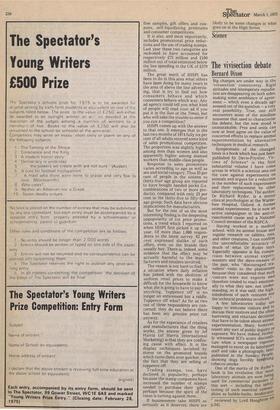Advertising
Below the line
Philip Kleinman
Did you know that in two out of every five cases the weekly shopping is now done by husband and wife together? That one in five shopping expeditions is carried out by hubby all on his own? That four in five shoppers confine most of their purchase to one store?
These are some of the fascinating details — well, they'd certainly fascinate you if you were in the grocery business or even only a grocer's daughter — to emerge from the latest survey carried out by the Harris International Sales Promotion Index. HISPI, run jointly by the Louis Harris research organisation and an unrelated company called Harris International Marketing, has been going for eighteen months now and is casting more and more light on the area mysteriously referred to the experts as below the line.
The phrase refers in fact to all the many different kinds of promotional expenditure apart from straightforward advertising in the media (the latter being classified as 'above the line'). 'Below the line' thus includes point-of-sale displays, free samples, gift offers and coupons, self-liquidating premiums and consumer competitions.
It is also, and most importantly, includes promotional price reductions and the use of trading stamps. Last year these two categories are reckoned to have accounted for respectively £75 million and £100 million out of total estimated below the line spending in the UK of £370 million.
The great merit of HISPI has been to do in this area what others have been doing for many years in the area of above the line advertising, that is try to find out how consumers behave and which consumers behave which way. Any ad agency could tell you what kind of people will read your ad if you put it in the Sun or the Times, but who will take the trouble to enter if you run a competition?
HISPI comes up with the answer to that one. It emerges that in the last two months of 1974 fully six per cent of all adults entered some kind of sales promotional competition. The proportion was slightly higher among men than women and also apparently higher among manual workers than middle-class people.
Response to sales promotions varies according to age as well as sex and social category. Thus 35 per cent of people in the sixteen to thirty-four age group are reported to have bought banded packs (i.e. combinations of two or more products), compared with only 23 per cent in the thirty-five to fifty-four age group. Such data have obvious implications for manufacturers.
But for the rest of us the most interesting finding is the deepening unpopularity of cut price promotions, a trend which I reported on when HISPI first picked it up last year. Of more than 1,000 respondents to the latest survey, 62 per cent expressed dislike of such offers, even on the brands they usually buy. There is, indeed, some evidence that the effect may be actually harmful to the manufacturers and retailers involved.
The reason is not hard to find. In a situation where daily inflation has joined with the abolition of uniform retail prices to make it difficult for the housewife to know what she is going to have to pay for anything, 'tuppence off' is no longer an enticement but a riddle. Tuppence off what? As far as two out of three respondents are concerned, they do not believe there has been any genuine price cut anyway.
As for the experience of retailers and manufacturers that the thing works, the answer given by Jef Harris (of Harris International Marketing) is that they are confusing cause with effect. It is the display techniques lavished by stores on the promoted brands which turns them over quicker, not the fact that they are selling at tuppence off.
Trading stamps, too, have declined in popularity, perhaps because the stamp companies have increased the number of stamps needed to purchase their 'gifts', perhaps because the spirit of the times is turning against them.
If businessmen take HISPI as seriously as it deserves, there are
likely to be some changes in what goes on in the High Street.


































 Previous page
Previous page